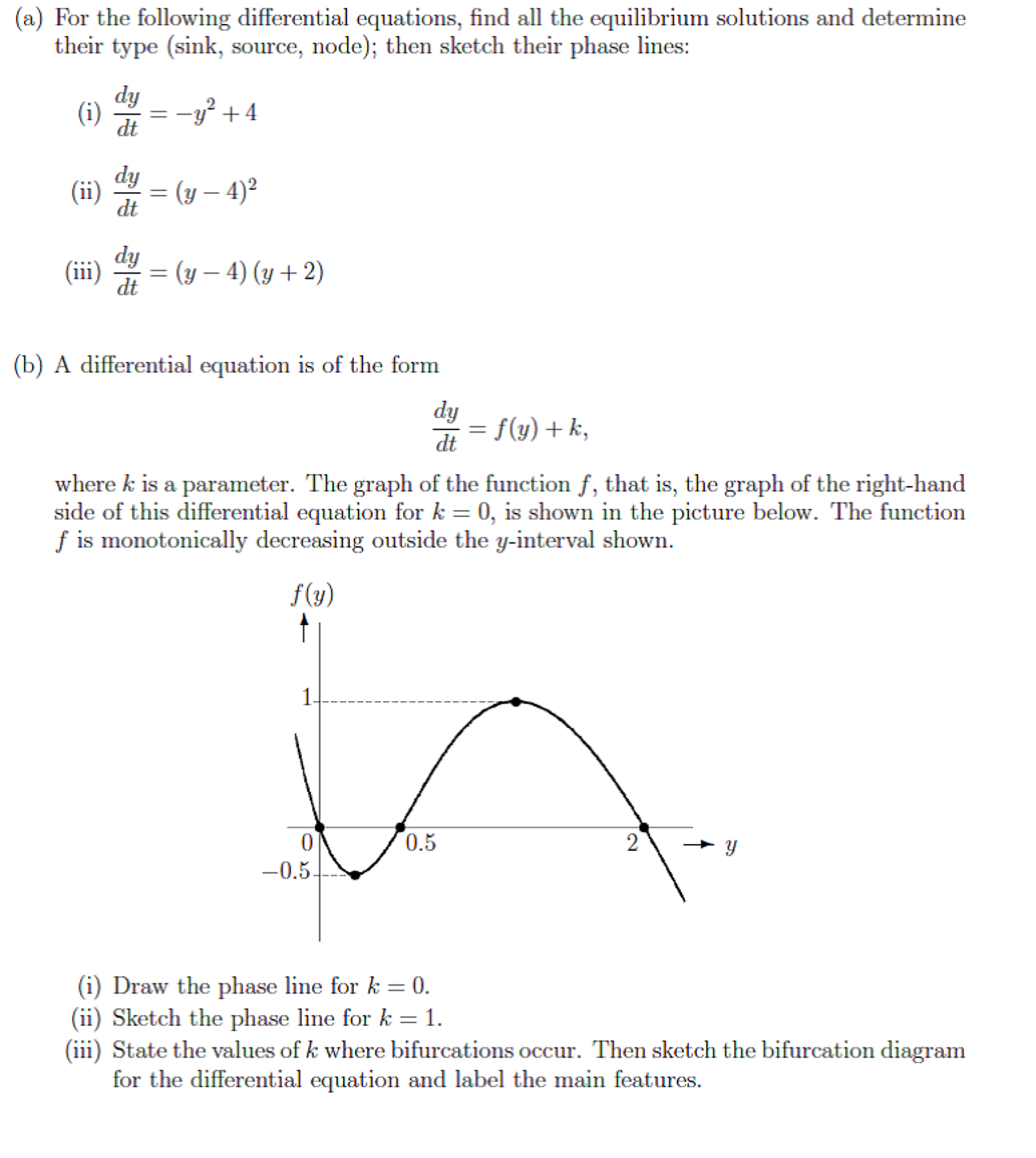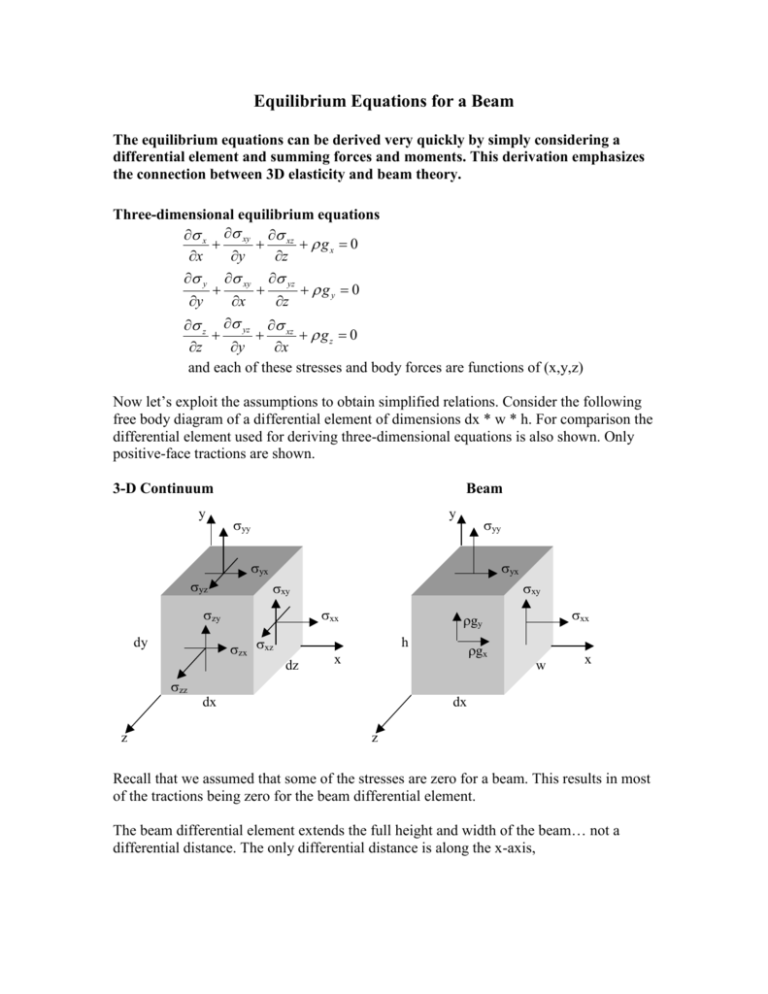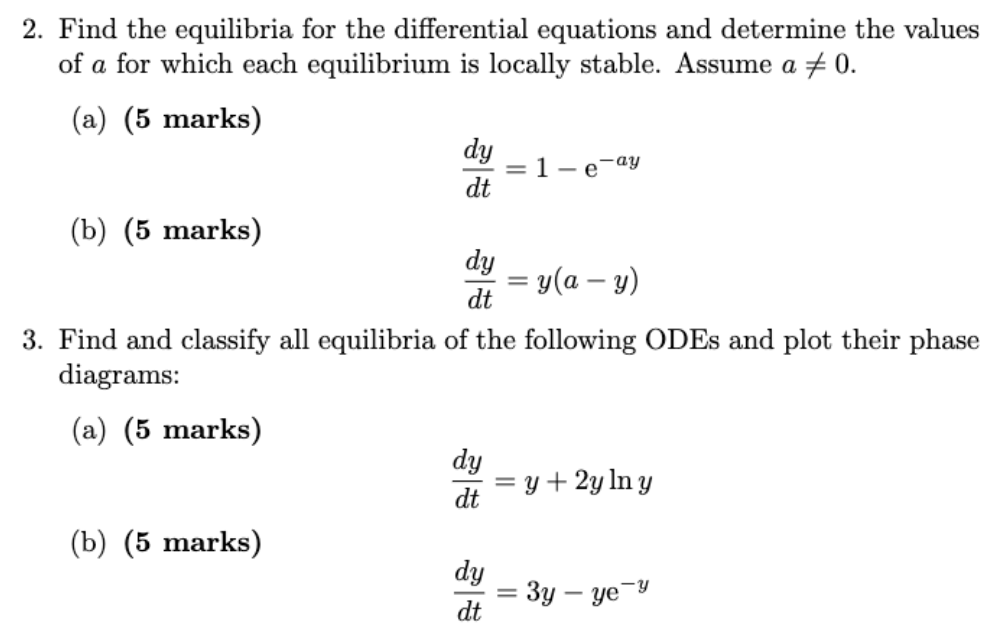Equilibrium Differential Equations - Suppose that f(6) = 0, f(14) = 0, and y(10) = 10. Sometimes it is easy to. Equilibrium solutions to differential equations. In studying systems of differential equations, it is often useful to study the behavior of solutions without obtaining an algebraic form. We know that a given differential equation is in the form y′ = f(y), where f is a differentiable function of y. Suppose that we have a differential equation $\frac{dy}{dt} = f(t, y)$. In this section we will define equilibrium solutions (or equilibrium points) for autonomous differential equations, y’ = f(y). Values of \(y\) for which \(f(y) = 0\) in an autonomous differential equation \(\frac{dy}{dt} = f(y)\) are called equilibrium.
We know that a given differential equation is in the form y′ = f(y), where f is a differentiable function of y. In studying systems of differential equations, it is often useful to study the behavior of solutions without obtaining an algebraic form. Values of \(y\) for which \(f(y) = 0\) in an autonomous differential equation \(\frac{dy}{dt} = f(y)\) are called equilibrium. Sometimes it is easy to. Suppose that f(6) = 0, f(14) = 0, and y(10) = 10. Suppose that we have a differential equation $\frac{dy}{dt} = f(t, y)$. In this section we will define equilibrium solutions (or equilibrium points) for autonomous differential equations, y’ = f(y). Equilibrium solutions to differential equations.
Suppose that f(6) = 0, f(14) = 0, and y(10) = 10. We know that a given differential equation is in the form y′ = f(y), where f is a differentiable function of y. Values of \(y\) for which \(f(y) = 0\) in an autonomous differential equation \(\frac{dy}{dt} = f(y)\) are called equilibrium. Sometimes it is easy to. In this section we will define equilibrium solutions (or equilibrium points) for autonomous differential equations, y’ = f(y). Suppose that we have a differential equation $\frac{dy}{dt} = f(t, y)$. In studying systems of differential equations, it is often useful to study the behavior of solutions without obtaining an algebraic form. Equilibrium solutions to differential equations.
Solved (a) For the following differential equations, find
In studying systems of differential equations, it is often useful to study the behavior of solutions without obtaining an algebraic form. Equilibrium solutions to differential equations. In this section we will define equilibrium solutions (or equilibrium points) for autonomous differential equations, y’ = f(y). Values of \(y\) for which \(f(y) = 0\) in an autonomous differential equation \(\frac{dy}{dt} = f(y)\).
Equilibrium solutions of differential equations Mathematics Stack
Suppose that we have a differential equation $\frac{dy}{dt} = f(t, y)$. Values of \(y\) for which \(f(y) = 0\) in an autonomous differential equation \(\frac{dy}{dt} = f(y)\) are called equilibrium. We know that a given differential equation is in the form y′ = f(y), where f is a differentiable function of y. In this section we will define equilibrium solutions.
Solved Derive the plane stress equilibrium equations
Equilibrium solutions to differential equations. In studying systems of differential equations, it is often useful to study the behavior of solutions without obtaining an algebraic form. Suppose that we have a differential equation $\frac{dy}{dt} = f(t, y)$. In this section we will define equilibrium solutions (or equilibrium points) for autonomous differential equations, y’ = f(y). Values of \(y\) for which.
Solved Find all equilibria for the following system of
We know that a given differential equation is in the form y′ = f(y), where f is a differentiable function of y. Equilibrium solutions to differential equations. In studying systems of differential equations, it is often useful to study the behavior of solutions without obtaining an algebraic form. Values of \(y\) for which \(f(y) = 0\) in an autonomous differential.
(PDF) Solving Differential Equations using PhysicsInformed Deep
Equilibrium solutions to differential equations. In this section we will define equilibrium solutions (or equilibrium points) for autonomous differential equations, y’ = f(y). We know that a given differential equation is in the form y′ = f(y), where f is a differentiable function of y. Values of \(y\) for which \(f(y) = 0\) in an autonomous differential equation \(\frac{dy}{dt} =.
Equilibrium equations
In this section we will define equilibrium solutions (or equilibrium points) for autonomous differential equations, y’ = f(y). We know that a given differential equation is in the form y′ = f(y), where f is a differentiable function of y. Suppose that f(6) = 0, f(14) = 0, and y(10) = 10. Sometimes it is easy to. Equilibrium solutions to.
SOLUTION Differential equilibrium equations Studypool
We know that a given differential equation is in the form y′ = f(y), where f is a differentiable function of y. Equilibrium solutions to differential equations. In studying systems of differential equations, it is often useful to study the behavior of solutions without obtaining an algebraic form. Values of \(y\) for which \(f(y) = 0\) in an autonomous differential.
What are the differential equations? Types of Differential Equations
Suppose that we have a differential equation $\frac{dy}{dt} = f(t, y)$. Sometimes it is easy to. Values of \(y\) for which \(f(y) = 0\) in an autonomous differential equation \(\frac{dy}{dt} = f(y)\) are called equilibrium. In studying systems of differential equations, it is often useful to study the behavior of solutions without obtaining an algebraic form. In this section we.
SOLUTION Differential equilibrium equations Studypool
Suppose that we have a differential equation $\frac{dy}{dt} = f(t, y)$. Suppose that f(6) = 0, f(14) = 0, and y(10) = 10. In studying systems of differential equations, it is often useful to study the behavior of solutions without obtaining an algebraic form. Equilibrium solutions to differential equations. Values of \(y\) for which \(f(y) = 0\) in an autonomous.
Solved 2. Find the equilibria for the differential equations
We know that a given differential equation is in the form y′ = f(y), where f is a differentiable function of y. Sometimes it is easy to. Values of \(y\) for which \(f(y) = 0\) in an autonomous differential equation \(\frac{dy}{dt} = f(y)\) are called equilibrium. In studying systems of differential equations, it is often useful to study the behavior.
Equilibrium Solutions To Differential Equations.
In studying systems of differential equations, it is often useful to study the behavior of solutions without obtaining an algebraic form. Sometimes it is easy to. Suppose that f(6) = 0, f(14) = 0, and y(10) = 10. In this section we will define equilibrium solutions (or equilibrium points) for autonomous differential equations, y’ = f(y).
Values Of \(Y\) For Which \(F(Y) = 0\) In An Autonomous Differential Equation \(\Frac{Dy}{Dt} = F(Y)\) Are Called Equilibrium.
Suppose that we have a differential equation $\frac{dy}{dt} = f(t, y)$. We know that a given differential equation is in the form y′ = f(y), where f is a differentiable function of y.









